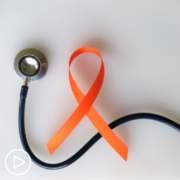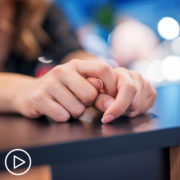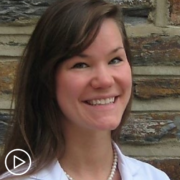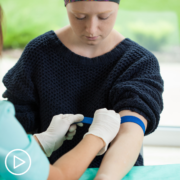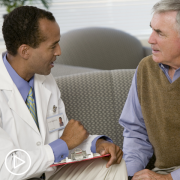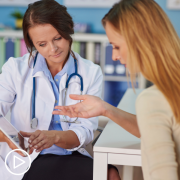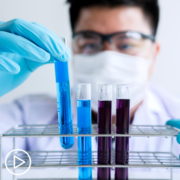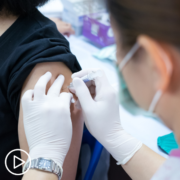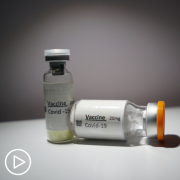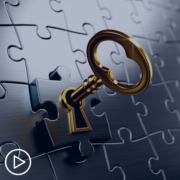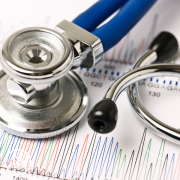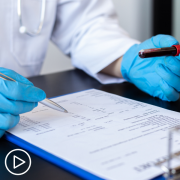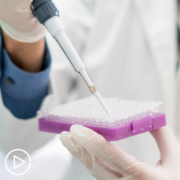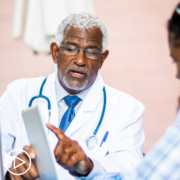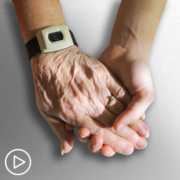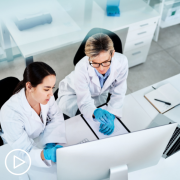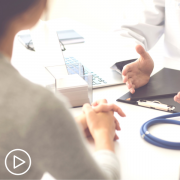Thriving With CLL: What You Should Know About Care and Treatment from Patient Empowerment Network on Vimeo.
What does it mean to thrive with chronic lymphocytic leukemia (CLL)? CLL expert Dr. Catherine Coombs discusses the goals of CLL care, reviews current treatment options, and shares tools for taking an active role in decisions.
Dr. Catherine Coombs is an Assistant Professor of Medicine in the Division of Hematology at The UNC Lineberger Comprehensive Cancer Center. Learn more about Dr. Coombs here.
See More from Thrive CLL
Download Program Guide
Related Resources:
Transcript:
Katherine:
Hello, and welcome. I’m Katherine Banwell, your host for today’s program. Today, we’re focusing on how to live and thrive with CLL. We’re going to discuss CLL treatment goals, and how you can plan an active role in your care.
Before we get into the discussion, please remember that this program is not a substitute for seeking medical advice. Please refer to your healthcare team about what might be best for you. Well, let’s meet our guest today. Joining us is Dr. Catherine Coombs. Dr. Coombs, welcome! Would you please introduce yourself?
Dr. Coombs:
My name is Catherine Coombs. I am an assistant professor of medicine at the University of North Carolina. My main patient practice is CLL and SLL patients, which make up probably about 80 percent of the patients I see. I do see a couple other types of leukemia and precursor states as well.
Katherine:
Thank you so much for taking the time out of your schedule to join us today; we appreciate it.
Dr. Coombs:
No problem. My pleasure.
Katherine:
Since this webinar is part of PEN’s Thrive series, I thought we could start with getting your opinion on what you think it means to thrive with CLL?
Dr. Coombs:
I’d say the first thing that comes to mind when I hear thriving in CLL is my goal for all my patients, which is to live their lives and enjoy their lives, and to not let CLL take over their lives in any way. But it’s of course important to be knowledgeable and educated about how the disease can impact one’s life. But I think there is a lot of education that can also go with that to help individuals continue to enjoy their lives and do most of the activities they like within reason.
Katherine:
This helps us guide us through the conversation, so thank you for that. Appropriate treatment obviously is part of thriving. Before we get into the specifics of CLL treatment approaches, how would you define treatment goals?
Dr. Coombs:
The first thing to jump into prior to going into treatment goals is asking the question, “Is treatment even needed?” CLL, in contrast to pretty much most other cancers, is not one of the cancers that needs to be treated immediately.
At least in 2022, there’s no proven benefit to early treatment. That is being questioned now that we have drugs that are much better tolerated. There are some nice clinical trials asking that question again, “Is early treatment beneficial?” At least what we know now is that is not the case. As it turns out, probably up to a third of patients with CLL never need treatment in their lifetime. That means that the disease progresses along usually at a slow pace, and individuals die from something else: any number of other potential causes of death.
The other two-thirds plus do need treatment at some point in their lifetime. The goals of treatment kind of depend on the patient. There’s not a one-size-fits-all approach in my view. I think it depends on what is most important to the patient.
I’ll give two drastic examples just to show how goals can be different. CLL often is a disease of older individuals. The average age of diagnosis is usually around 70 or so. But many patients have the disease for a few years, if not longer, prior to needing therapy. So, one example patient could be an 85-year-old individual who has had the disease for a decade and finally needs treatment. The goals of that patient may be to control disease, but he or she may not be worried about going into a deep remission, and may be very, totally willing to be on a drug. And definitely in order to control the disease, alleviate disease-related symptoms, but perhaps not get into a deep remission.
The other patient, just to take it to another far extreme, I work in an academic medical center; I see some very young patients which is not the norm in CLL, but it does happen.
Say it’s a 40-year-old patient. His or her goals may be very different. They may not like the idea of being on an oral therapy indefinitely or until progression. So, the goals for that patient may be different. They may say, “Gosh, I’d like to do something a bit more intense to be able to be off of therapy.”
So, I think in the end there’s no one-size-fits-all approach. It generally, for my clinic, comes down to a discussion with the patient talking about what their goals are: is it more important to be off therapy for some period of time and they’re willing to sacrifice a bit more intensive of a schedule? Or are they more appealing to be on a regimen that they’re on indefinitely provided that it still provides disease control and alleviation of the disease-related symptoms.
Katherine:
That leads me to my next question, which is what is the patient’s role in setting care goals?
Dr. Coombs:
I think they should have a huge role; it should be a shared decision between the patient and their cancer doctor. I think at least as of now, there’s not one proven best therapy. We have a number of therapies that work extremely well. But they differ quite a bit with respect to the schedule, the possible side effects profile, and sometimes in the cost, depending upon the patient’s insurance.
Knowing that there’s not a superior therapy, I think the best approach would be to discuss all of the therapies that are highly effective, and then compare and contrast what those therapies may look like for the patient and then make a shared decision.
Katherine:
I have a follow-up question to what we were talking about a moment ago. What would you say to a patient who has a lot of anxiety about having to wait for treatment?
Dr. Coombs:
The first thing I would say is that anxiety is normal. More often patients are anxious than not because it’s really hard to be told you have a leukemia and that we’re not going to do anything about it. I think that’s really hard to hear. The way that I try to counsel people is that my role as the doctor is to do no harm. If you have a leukemia and there’s no proven way to make you live longer by giving therapy early on, if you’re in that early stage of CLL where you’re asymptomatic, by offering therapy, all I could do is make you worse.
I could give you a new side effect, I could add a new cost burden – Until I have data to prove that that’s going to make your life longer, which we do not have yet (maybe that will be different five to 10 years from now, but we do not have that yet), I could only hurt you. So, that’s not what I want to do. I want to have you live and thrive.
The better thing to do, based on what we know now and what we know our therapies can and can’t do is to do the watchful waiting. But the anxiety is normal. Depending on how severe the anxiety is, I have had patients meet with – at least at UNC we have something called the Cancer Center Support Program, which is a group of psychiatrists, psychologists, therapists that can help talk over what it means to have a cancer diagnosis and not necessarily need therapy.
Then I also provide education on the other health issues that can come up as part of being a CLL patient even on that watchful waiting program. The thing that we talk about the most is the increased risk for infections, which in the era of the COVID pandemic is a major concern. Luckily, we have a lot of ways to decrease the health risk for COVID, whether it’s due to the administration of vaccines, or monoclonal antibodies, which I think we’ll talk about more later.
There’re a lot of ways that people can live with it. I do think the anxiety is normal. At least in my own practice, I’ve found that most of the time the anxiety lessens with time. Because it becomes a part of who you are. It doesn’t have to be all of who you are: people can live their lives largely the way they did before with a bit of extra knowledge about things that can come up in the future but may never come up at all.
Katherine:
Let’s walk through the types of treatments that are used today to treat CLL.
Dr. Coombs:
So, for the non-watch and wait category, that means we are now thinking about therapy. Most of the time that involves a targeted agent.
We largely are using a lot less in the way of cytotoxic chemotherapy. Not to say there isn’t a role for it, but in my own practice, it’s not something that I have been using in the past several years because it’s highly toxic. It is effective, but it can lead to some long-term toxicities. And it’s also not quite as effective as these new targeted agents. So, those fall into two major classes.
The first class is a class of drugs called BTK inhibitors. That stands for brutons tyrosine kinase. That’s an important target in the CLL cells, specifically. The CLL cells are a type of B-cell. So, BTK is important for the signaling of both normal and cancerous B-cells. When we use drugs to block that protein, that impairs the CLL cells’ ability to multiply. Then we ultimately are able to control the disease with prolonged administration of one of these drugs.
There are two FDA-approved BTK inhibitors. The first FDA-approved agent is a drug called ibrutinib. And then the newer agent is called acalabrutinib. There’s another drug that you may have heard of called zanubrutinib. That is not technically yet FDA-approved for CLL, but it is occasionally used given that it is FDA-approved for other lymphomas, and it is within the national cancer center network guidelines for CLL treatment.
The big benefit of these drugs is they work phenomenally well at controlling the CLL. I would say the major downside is that they do have to be taken indefinitely. So, patients ask, “Am I going to be on it forever?” Well, it depends on what you mean by forever. We generally keep patients on these drugs as long as No. 1 they’re tolerating them, so no bad side effects, and then No. 2 as long as the CLL is staying under control.
So, for that 85-year-old patient that I gave as an example, forever may be until the rest of their life. Because they can work for six, seven, eight plus years; so, they’re highly effective. Some patients may go on them and then die from something else years down the road. For the younger patients, or patients who progress faster, we would then put them on something else whenever the drug stopped working, provided that they didn’t have a significant side effect to the drug class. So, that’s a big first class.
The second large subset of therapies is a drug called venetoclax, which we typically combine with an anti-CD20 drug. The one that we use for patients who are getting their first treatment is called obinutuzumab. Venetoclax is a BCL-2 Inhibitor that inhibits this pathway within CLL cells. It’s not unique to CLL cells, but the CLL cells are particularly dependent upon it called apoptosis.
So, when they get exposed to this drug, the CLL cells just die; they can’t continue living, they die off. So, venetoclax works really exquisitely well at killing off CLL cells. Probably works better when it’s paired with this drug obinutuzumab. That’s how it was approved in the frontline setting: those two drugs together. The big risk of that therapy, essentially, it’s kind of a weird risk, when the CLL cells die too quickly that can cause some problems in the human body because one has to metabolize all the debris left over from these dead cancer cells. The medical term we use for that is Tumor Lysis Syndrome.
That can actually be fatal if not done in a safe way. Fortunately, when we do it as per the recommendations by the manufacturer, we’ve not had any adverse severe problems from it. It ends up being that the patient has to come in weekly every five weeks to do a slow ramp-up of the drug to kind of slowly kill off the cancer cells so that the body isn’t overwhelmed by the contents of these dead cancer cells.
The big advantage of this regimen is that because it kills the CLL so well, people can get into very deep remissions. So, instead of being a therapy that people are on indefinitely, it’s designed as a one-year therapy when given as the first therapy. So, it’s one year and then they’re done. People after that are in remission, they’re not on any treatment. They may feel like they don’t have CLL.
Most of the time the CLL does come back. It depends on does the patient come back for something else? Which does happen when people are older. But it appears that it keeps people in remission for several years. The median, which is how long it takes for half of patients to have their disease come back, the median progression for survival has not yet been reached for the trial that was done using this therapy.
So, that’s at least three, four plus years that we’ve been able to follow people. So, very attractive in that you’re done and then you just wait for the disease to come back but largely feel good in the interim.
Katherine:
When is it time to treat? What factors do you look at?
Dr. Coombs:
There’s pretty well-established guidelines for when treatment is indicated. The international workshop for CLL has these published guidelines, so it’s something you could google. Off the top of my head, the main reasons that I do treatment, which are included in these guidelines, are 1.) If the patient has low blood counts due to the CLL, so that could be anemia or low platelets. 2.) If they have bulky lymph nodes. They actually define bulky as 10 cm. So, that’s pretty big.
Or, if the lymph nodes are being symptomatic in some way, they’re bothering the patient, they don’t have to be that big. 3.) If the patient has bulky spleen enlargement or if it’s causing symptoms. The spleen is next to the stomach. So, say some patients may not be able to eat a full meal, that’s another reason we could do treatment.
Another reason is if the CLL is causing constitutional symptoms. Sometimes these are black and white. One is unintentional weight loss of 10 percent or more of the body weight. The one that’s not always black and white is fatigue. Patients can have fatigue from the CLL, but I’ve found often fatigue can be due to other causes. So, that’s something I consider an important job of mine is to make sure we don’t jump into CLL treatment if say, there’s some other cause for the tiredness, such as, say the thyroid’s off or there’s a huge amount of stress due to some other factor outside of the CLL.
Then, some other constitutional symptoms are CLL can cause fever or drenching night sweats. Those two it’s important to make sure that there’s not a concurrent infection because infections can also cause those symptoms. The last indication is patients with CLL can develop autoimmune cytopenias. That’s when the immune system attacks some component of the blood cells. Most commonly that’s an autoimmune anemia or autoimmune thrombocytopenia. That’s the term for low platelets.
Usually, we can treat that with steroids or occasionally CD-20 by itself like rituximab to calm down the immune system. However, if those immune-based therapies fail the patient, then we could consider treating the CLL to help fix that problem.
Katherine:
We received an audience question prior to the program. They asked, “What does it mean to be refractory, and how is that different from relapsing?”
Dr. Coombs:
I actually just had a conversation about this. I’m not sure that’s formally defined. I have heard one definition suggested is – I think everyone agrees refractory means you did not respond to your last therapy. That’s actually really bad. Most of our therapies work in almost everyone. So, refractory is a term that is generally accepted means no response. So, whatever therapy you’re on, the CLL did not get better, it got worse. That’s refractory.
Another definition that I’ve heard based on this recent discussion is if you had a short remission duration, such as six months or shorter. Most of the therapies we use should work for quite a while, usually on the order of years. So, some people also consider refractory a short remission duration, six months or shorter.
Relapse is probably the more common scenario. That’s a patient who has had some type of therapy, but they had a decent response, but that response wore off, more on a normal pace. Again, not on the order of months, but usually on the order of years.
Katherine:
There’s not necessarily a one-size-fits-all approach to treating CLL, so how do you decide which treatment is right for a patient?
Dr. Coombs:
I always look at their underlying disease biology. There’s a couple really important tests that I send for all of my CLL patients by the time that they need therapy. The first is to see what their underlying cytogenetics and molecular findings are. There are certain good findings, and then certain bad findings.
One of the bad findings is having a deletion in the 17th chromosome in the short arm of that chromosome. The chromosomes are the big pieces of DNA within everyone’s cells. There are findings that are common in CLL: a 17p deletion is a poor prognostic feature. There’s a separate test where we can actually identify mutations in a gene called TP53. And these behave largely the same as 17p deletions, so I always check for both. It’s two different tests.
Often times patients have both of these findings: a 17p deletion and a TP53 mutation. But sometimes you can have the mutation without the deletion and vise versa. That is one finding that’s important when talking about different therapies. The other really important prognostic test is the IGHV gene mutation status. This is another specialized sequencing test. It looks to see if the patient’s heavy chain, if their immunoglobulin protein has undergone something called somatic hypermutation or not.
It’s actually good to be mutated. What we know about people who are mutated is that they typically have better responses to most therapies and their disease typically is one that grows slower. So, I use those factors and then I have a conversation with the patient. The two main treatment classes that I spoke about – so the BTK Inhibitors, those work actually really well and even the people with these bad prognostic features. So, people with the 17p deletion, people with the TP53 mutation, they can have disease control for six plus years on a BTK inhibitor, which is really good.
That was not the case a decade ago when we didn’t have these drugs. That’s something that’s been hugely beneficial for our patients. The venetoclax/obinutuzumab regimen, that still works when people have the 17p or the TP53, but it probably doesn’t work as well.
I’d mentioned the median time for disease to come back hadn’t been reached yet. It had been reached for that poor risk subset. The expectation for people with that poorest marker is that the median PFS, progression-free survival. So, again, when after someone starts therapy, when the disease then progresses is 49 months. It kind of gives me a rough estimate of, “Gosh, these are your therapy options and based on your underlying biologic factors unique to your disease, this is what you can expect out of therapy A or therapy B.”
The mutated or unmutated IGHV, similarly, those BTK inhibitors work extremely well, even in people with the bad unmutated finding. I think those are always an option. The other treatment is an option, but the people with that bad finding do have a shorter time until they progress of just under five years.
Katherine:
Dr. Coombs, why should patients feel confident in speaking up and being a partner in their care? Do you have any advice for helping them find their voice?
Dr. Coombs:
Great question. I think a patient is their own best advocate. We as their physicians always try to advocate for them, but we often don’t know what their wishes and desires are. I think through speaking to what’s important to you, that can help me know a little more about what path we should take. There’s not always one right path.
I’ve talked about these two great treatment options we have. I had one patient who loved fishing and he just didn’t want to be in the infusion center. That’s the person that should go on the oral drug, where he doesn’t have to come to and from as often.
If you tell us about your goals and your desires, that helps us also be your top advocate because then we have a little more background for what’s important to you. I think that’s my main thought. We’re here for you, but we need to know what you value the most. We don’t always know that.
Katherine:
When should a patient consider a second opinion or a consultation with a specialist?
Dr. Coombs:
I never discourage a second option. I’m a CLL specialist, but I’ve had patients ask for a second opinion. I’m always enthusiastic about it. If a patient feels that they need another set of eyes on their case. I’ve learned some things from some of my patients who have seen specialists in different areas of the country or locally. We have Duke down the street. Sometimes different providers just have different perspectives.
Or, sometimes the patient just needs to hear something again if it doesn’t sound right to them. I’ve had patients for example who are one watchful waiting who really just had trouble believing. “I have leukemia, and you’re really telling me to do nothing.” But then they hear it from someone else and it just helps it sink in. I’d say the answer is anytime. Anytime you think you need another set of eyes on the case.
But I would say especially for people in the community. I do think there’s a lot of value in seeing a CLL specialist once if it’s something that you’re interested in and your insurance pays. I think the community docs have one of the hardest jobs, and I don’t think I could do it. There are so many different cancers that they have to know about. I think, if anything, I have the easy job; I have one tiny slice of the pie that I know a ton about. Not to say they don’t do great jobs; I’m actually phenomenally impressed with most of the community.
However, they have so much to know, often you can maybe get a little more of a unique view on CLL by seeing a CLL expert. If that’s in your interest. But certainly not mandatory, especially if your goal is to stay away from doctors.
Katherine:
COVID is of course another factor that impacts a patient’s ability to fully thrive with CLL in today’s world. Many CLL patients are concerned about the effectiveness of the COVID vaccines and their ability to make enough antibodies to fight the virus. So, what do we know about how effective the COVID vaccines are for people with CLL?
Dr. Coombs:
The COVID vaccines – we were fortunate in being able to build on some earlier research. Even prior to being able to look at the data for COVID vaccines, there have been studies looking at vaccines in general in CLL. That’s actually been a long-term established issue, which is that based on earlier studies we knew most vaccines were not as efficacious in individuals with CLL compared to people without.
That’s due to this underlying immune deficiency. Since then, they’ve done studies looking at COVID specifically, and we have found lower rates of production of antibodies in individuals with CLL compared to regular, non-CLL controls. There have been a few different studies looking at this. I think the things that have been seen universally is that the CLL patients that are the most severely affected are those that are actively on therapy or have had recent anti-CD20. The CD20 drugs really wipe out the ability to make antibodies probably for a year, if not up to two years.
The other drug class that can really hamper the ability to make antibodies are these BTK inhibitors. Then, venetoclax to some extent, it’s often paired with the CD20, so it’s hard to tease out the effect. But it likely hampers the ability to make antibodies as well, but just not as much as the CD20, which it’s often given concurrently with.
CLL patients who have never had therapy can make a decent amount of antibodies, but still quite a bit less than an age-matched control. So, someone also your age without CLL. That was a lot of data based on the original two vaccine series. The Leukemia Lymphoma Society did a study that I actually referred a lot of my patients to, where they collected samples, looked at antibody levels, and they found that giving the booster did seroconvert a good amount of patients who were negative that then became positive for antibodies.
That’s one of the reasons I’ve really encouraged the booster. This is now talking about the third shot. Now there’s this whole separate discussion about doing a fourth shot. I think the data’s a little too early to say it’s definitely helpful. But I think it’s certainly unlikely harmful. The vaccines don’t quite work as well. I feel very strongly they’re not harmful.
Not to say any shot can’t cause some issue occasionally. But I think that’s very, very rare. I always encourage my patients to get the vaccine, but I separately say, “Gosh, I wouldn’t use this as an end-all cure because it may not work at its 100 percent efficacy level due to the underlying CLL, and worse when you’re under treatment.”
Katherine:
We had another audience member send in a related question: “I’ve heard there is a treatment to help boost COVID antibodies. What is it and how can I get access to it?”
Dr. Coombs:
I was going to bring that up actually, then I figured there was probably another question coming. I’m hugely enthusiastic about the drug that this person is speaking about. It’s called Evusheld. E-V-U-S-H-E-L-D. It got this emergency use authorization designation in December of 2021, so it’s pretty new. The idea behind this drug is that “Gosh, we know that not everyone is going to mount an effective immune response to vaccines, based on their own immune system, inability to make good levels of antibodies.”
So, it’s two antibodies that were manufactured as this drug. So, it’s a drug that’s actually two different antibodies. It ends up being in two different vials, so you get two shots. It provides really remarkable protection against COVID. They’re long-acting antibodies, so they last for six months.
The publication from the study that led to this being released showed an approximately 80 percent reduction in COVID for the people who got the shot as opposed to the people who got the placebo.
Katherine:
It sounds like patients could ask their doctors about where they might be able to access this?
Dr. Coombs:
Yeah. I think the best person to ask would be your CLL doctor. Because the drug, unless things have changed recently, it’s largely being focused for immunosuppressed individuals. Primary care doctors may not necessarily know a lot about it, but most oncologists are the ones who should have access to it. So, I would say ask your CLL doctor. If you’re in a smaller site that doesn’t have it, they may know in your geographic region where it could be gotten.
Katherine:
As we close out this conversation, Dr. Coombs, I wanted to hear why you feel patients should be hopeful about the potential to thrive with CLL?
Dr. Coombs:
There’s just so many reasons to be hopeful. CLL, I’d say more than – obviously it’s the cancer I’m focused on, but I think more than almost any other cancer has had advances that have really changed the lives of our patients in the last decade. And that’s only going to get better.
We have therapies that work phenomenally well and can get you into remission, get the CLL under control, and let you just live your life as you wish; almost as though the CLL is not there. Though, it is in the background and your doctor can counsel you on special precautions needed. The drugs we have are phenomenal, but we only use them when we need them. Again, we don’t want to give you something you don’t need. But when you need it, the options we have are really phenomenal and they work well.
They have some side effects, but I’d say they’re much better than the side effects of the older fashion drugs we used to use a decade-plus ago. The disease is there, we have better ways to control it, and I think there’s plenty of reasons to live your life, enjoy your life, thrive. We’ll take care of the CLL with all these tools in our toolbox when we need to.
Katherine:
Dr. Coombs, thank you so much for joining us today.
Dr. Coombs:
It’s been my pleasure, thank you.
Katherine:
And thank you to all of our partners. To learn more about CLL and to access tools to help you become a proactive patient, visit powerfulpatients.org. I’m Katherine Banwell. Thanks for joining us.


